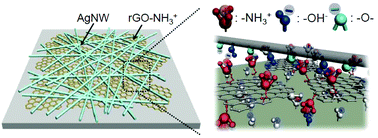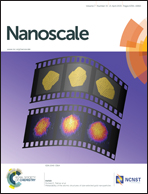Positively-charged reduced graphene oxide as an adhesion promoter for preparing a highly-stable silver nanowire film†
Abstract
An ultrathin conductive adhesion promoter using positively charged reduced graphene oxide (rGO-NH3+) has been demonstrated for preparing highly stable silver nanowire transparent conductive electrodes (AgNW TCEs). The adhesion promoter rGO-NH3+, spray coated between the substrate and AgNWs, significantly enhances the chemical and mechanical stabilities of the AgNW TCEs. Besides, the ultrathin thickness of the rGO-NH3+ ensures excellent optical transparency and mechanical flexibility for TCEs. The AgNW films prepared using the adhesion promoter are extremely stable under harsh conditions, including ultrasonication in a variety of solvents, 3M Scotch tape detachment test, mechanical bending up to 0.3% strain, or fatigue over 1000 cycles. The greatly enhanced adhesion force is attributed to the ionic interactions between the positively charged protonated amine groups in rGO-NH3+ and the negatively charged hydroxo- and oxo-groups on the AgNWs. The positively charged GO-NH3+ and commercial polycationic polymer (poly allylamine hydrochloride) are also prepared as adhesion promoters for comparison with rGO-NH3+. Notably, the closely packed hexagonal atomic structure of rGO offers better barrier properties to water permeation and demonstrates promising utility in durable waterproof electronics. This work offers a simple method to prepare high-quality TCEs and is believed to have great potential application in flexible waterproof electronics.


 Please wait while we load your content...
Please wait while we load your content...